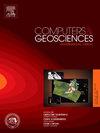Optimizing managed artificial recharge backwash using a multi-objective particle swarm optimization coupled with a clogging simulation model
IF 4.2
2区 地球科学
Q1 COMPUTER SCIENCE, INTERDISCIPLINARY APPLICATIONS
引用次数: 0
Abstract
Artificial recharge (AR) plays an important role in the management of groundwater resources and the mitigation of hydrogeological problems. However, challenges related to clogging inevitably arise during groundwater recharge. Although the clogging mechanism during groundwater recharge has been intensively studied in the past decades, there is a relative scarcity of studies focused on strategies for preventing clogging through artificial interventions. This study introduces an optimization framework that integrates a clogging model with two objective functions to obtain an optimized backwashing strategy aimed at minimizing clogging during groundwater recharge. The proposed clogging model for the groundwater recharge process considers both physical clogging (attachment of suspended solids) and chemical clogging (iron oxide clogging) by coupling COMSOL and PHREEQC models. The Multi-Objective Particle Swarm Optimization (MOPSO) algorithm was used to obtain the Pareto-optimal solutions, by evaluating the clogging conditions and recharge efficiencies of different strategies, which enables stakeholders to determine suitable backwashing frequency and duration among various groundwater backwashing strategies. The results indicate that optimized backwashing strategy can significantly reduce clogging in groundwater recharge projects. With the highest backwashing frequency and duration, clogging near the recharge wells would be reduced to 90% of that observed during normal recharge without strategies, and the time spent on backwashing would only constitute 4.8% of the recharge time.
基于堵塞仿真模型的多目标粒子群优化人工补给反冲洗
人工补给在地下水资源管理和缓解水文地质问题方面发挥着重要作用。然而,在地下水补给过程中,不可避免地会出现堵塞问题。虽然在过去的几十年里,地下水补给中的堵塞机制已经得到了深入的研究,但通过人工干预来防止堵塞的研究相对较少。本研究引入了一个将堵塞模型与两个目标函数相结合的优化框架,以获得一个优化的反冲洗策略,该策略旨在最大限度地减少地下水补给过程中的堵塞。提出的地下水补给过程堵塞模型通过COMSOL和PHREEQC模型耦合考虑了物理堵塞(悬浮固体的附着)和化学堵塞(氧化铁堵塞)。采用多目标粒子群优化(MOPSO)算法,通过评价不同策略的堵塞情况和回灌效率,得到pareto最优解,使利益相关者能够在各种地下水反冲洗策略中确定合适的反冲洗频率和持续时间。结果表明,优化后的反冲洗策略可以显著减少地下水补给工程的堵塞。在反冲洗频率和持续时间最高的情况下,回灌井附近的堵塞将减少到正常回灌时的90%,而反冲洗时间仅占回灌时间的4.8%。
本文章由计算机程序翻译,如有差异,请以英文原文为准。
求助全文
约1分钟内获得全文
求助全文
来源期刊

Computers & Geosciences
地学-地球科学综合
CiteScore
9.30
自引率
6.80%
发文量
164
审稿时长
3.4 months
期刊介绍:
Computers & Geosciences publishes high impact, original research at the interface between Computer Sciences and Geosciences. Publications should apply modern computer science paradigms, whether computational or informatics-based, to address problems in the geosciences.
 求助内容:
求助内容: 应助结果提醒方式:
应助结果提醒方式:


